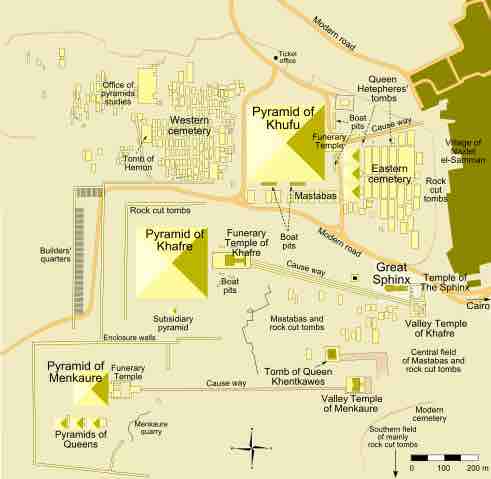Ancient Egyptian architects carefully planned buildings, aligning them with astronomically significant events, such as solstices and equinoxes. They used mainly sun-baked mud brick, limestone, sandstone, and granite. Stone was reserved for tombs and temples, while other buildings, such as palaces and fortresses, were made of bricks.
Pyramids
Egyptian pyramids referenced the rays of the sun, and appeared highly polished and reflective, with a capstone that was generally a hard stone like granite, sometimes plated with gold, silver or electrum. Most were placed west of the Nile, to allow the pharaoh's soul to join with the sun during its descent.
Old Kingdom Pyramid Temple Reconstruction
In this reconstruction, a causeway leads out to the valley temple.
About 135 pyramids have been discovered in Egypt, with the largest (in Egypt and the world) being the Great Pyramid of Giza. Its base is over 566,000 square feet in area, and was one of the Seven Wonders of the Ancient World. The Giza Necropolis, built in the Fourth Dynasty, includes the Pyramid of Khufu (also known as the Great Pyramid or the Pyramid of Cheops), the Pyramid of Khafre and the Pyramid of Menkaure, along with smaller "queens" pyramids and the Great Sphinx.

Map of Giza Pyramid Complex
A map showing the layout of the Giza Pyramid area, including the Pyramids of Khufu, Khafre, Menkaure, and the Great Sphinx.
The Great Sphinx of Giza
This limestone statue of a reclining sphinx (a mythical creature with a lion's body and a human head) is located on the Giza Plateau to the west of the Nile. It is believed the face is meant to represent the Pharaoh Khafra. It is the largest and oldest monolith statue in the world, at 241 feet long, 63 feet wide, and 66.34 feet tall. It is believed to have been built during the reign of Pharaoh Khafra (2558-2532 BCE). It was probably a focus of solar worship, as the lion is a symbol associated with the sun.
The Great Sphinx of Giza
Here the Great Sphinx is shown against the Pyramid of Kahfre.
Temples
Egyptian temples were used for official, formal worship of the gods by the state, and to commemorate pharaohs. The temple was the house dedicated to a particular god, and Egyptians would perform rituals there, give offerings, re-enact myths and keep order in the universe (ma'at). Pharaohs were in charge of caring for the gods, and they dedicated massive resources to this task. Priests assisted in this effort. The average citizen was not allowed into the inner sanctum of the temple, but might still go there to pray, give offerings, or ask questions of the gods.
The inner sanctuary had a cult image of the temple's god, as well as a series of surrounding rooms that became large and elaborate over time, evolving into massive stone edifices during the New Kingdom. Temples also often owned surrounding land and employed thousands of people to support its activities, creating a powerful institution. The designs emphasized order, symmetry and monumentality. Hypostyle halls (covered rooms filled with columns) led to peristyle courts (open courts), where the public could meet with priests. At the front of each court was a pylon (broad, flat towers) that held flagpoles. Outside the temple building was the temple enclosure, with a brick wall to symbolically protect from outside disorder; often a sacred lake would be found here. Decoration included reliefs (bas relief and sunken relief) of images and hieroglyphic text and sculpture, including obelisks, figures of gods (sometimes in sphinx form), and votive figures. Egyptian religions faced persecution by Christians, and the last temple was closed in 550 AD.
The Temple of Karnak was first built in the 16th century BCE. About 30 pharaohs contributed to the buildings, creating an extremely large and diverse complex. It includes the Precincts of Amon-Re, Montu and Mut, and the Temple of Amehotep IV (dismantled).
Temple of Karnak
This view of the Temple of Karnak shows they hypostyle hall, with massive columns.
The Luxor Temple was constructed in the 14th century BCE by Amenhotep III in the ancient city of Thebes, now Luxor, with a major expansion by Ramesses II in the 13th century BCE. It includes the 79-foot high First Pylon, friezes, statues, and columns.
Luxor Temple
Shown here is the entrance pylon of Luxor Temple, one of the major New Kingdom temples.